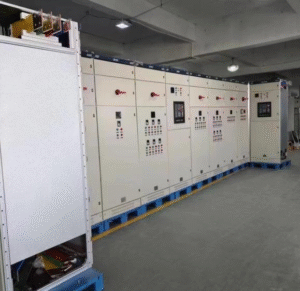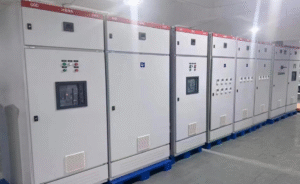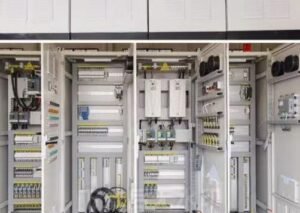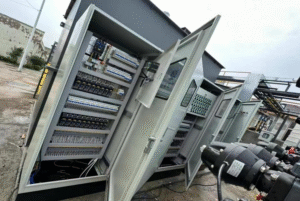
Analysis of key points in the design of electrical control cabinet: comprehensive consideration from structure to intelligence
As the core component of industrial automation system, the quality of electrical control cabinet directly determines the stability and safety of equipment. This paper will discuss eight core design principles to build an efficient and reliable electrical control cabinet system.

I. Structural layout design: balance of function and efficiency
Adopt the “Three-layer Architecture” design philosophy: The upper layer houses human-machine interfaces (HMI), indicator lights, and other interactive components; the middle layer centralizes main circuit devices such as circuit breakers and contactors; the lower layer installs control units including PLCs and frequency converters. Cable management optimization: Dedicated cable troughs achieve separation of high-voltage and low-voltage circuits, maintaining a minimum 30cm spacing between power cables and signal cables. Utilizing pre-terminated wire harnesses and label management systems reduces wiring errors by 80% and maintenance time by 50%. Heat dissipation channel planning: Design ventilation ducts based on power distribution of heat-generating components to ensure unobstructed natural airflow pathways. For systems exceeding 20kW, CFD simulation is required to optimize airflow organization.
2. Thermal management design: ensure the life of core components
Heat Dissipation Solution Selection Natural Cooling: Suitable for power density <0.5W/cm² scenarios, utilizing aluminum profile heat sinks with thermal grease. Forced Air Cooling: Combines EC fans with temperature control modules to maintain device temperature rise ≤25K in 40℃ environments. Liquid Cooling: Optimizes cabinet temperature by 10-15℃ for high-heat-generating devices like IGBTs. Temperature Monitoring System: Equipped with multi-channel PT100 sensors for real-time monitoring of critical temperature points. Features three-tier alarm mechanism: Early Warning (70℃), Load Reduction (80℃), and Shutdown (90℃).
3. Security Protection System Construction Protection Level Compatibility
Select IP ratings based on application scenarios: Indoor standard equipment uses IP54, outdoor applications require IP65, and special environments like coal mines demand IP68. Conductive foam is applied at door seams to achieve EMI shielding. Electrical Isolation Design: The main circuit and control circuit are isolated with a voltage withstand capability exceeding 300V. Digital inputs utilize opto-coupler isolation, while analog signals incorporate transient voltage suppression diodes (TVS). Emergency Protection Mechanism: Dual-channel emergency stop circuits are installed, with phase sequence protectors and residual current devices (RCDs) configured for the main power supply. A line reactor is added to the inverter drive circuit to suppress harmonic interference.
4. Electromagnetic Compatibility (EMC) Design Grounding System Optimization
Implement a star-connected grounding structure to ensure the control cabinet’s grounding resistance remains ≤100mΩ. The signal ground and power ground are connected via a single-point ferrite bead configuration to prevent ground loop interference. EMI Filtering Technology Application: Install EMI filters at the power supply input and apply dv/dt filters at the inverter output. Sensitive analog circuits utilize a combination of common-mode chokes and capacitive filtering. Shielding Effectiveness Verification: Conduct near-field probe scanning to detect radiation leakage, ensuring emissions in the 30MHz-1GHz frequency band comply with the CISPR Class A limit of 11.


5. Maintainability Design Strategies
1. Quick Maintenance Design: Utilize front-opening modular design with pull-out modules, ensuring critical components can be maintained within 15 minutes. Reserve over 30% space for spare terminals and installation to facilitate future expansion. 2. Intelligent Diagnostic Interface: Integrated with 485/Ethernet interfaces and Modbus TCP protocol support. Edge computing modules enable self-diagnosis, reducing Mean Time Between Failures (MTTR) by 60%.3. Digital Twin Application: Establishes 3D model-to-physical mapping. Maintenance personnel can access real-time equipment data through AR glasses, enabling remote expert guidance.
6. Standardization and Modularization Practices
1. Component Library Development: Established a component selection library based on IEC 61439 standards, covering over 80% of general-purpose components. Developed parametric design tools that automatically generate wiring diagrams and BOM lists. 2. Functional Module Repurposing: Encapsulated power modules, I/O modules, communication modules, etc., into standardized units for plug-and-play implementation via backplane buses. A vehicle production line project achieved a 40% reduction in design cycle through modular design.
7. Intelligent Upgrade Pathways
1. IoT Integration Solution Install edge computing gateways to enable cloud-based data synchronization for devices. Connect via the MQTT protocol to industrial internet platforms, supporting predictive maintenance capabilities. 2. Energy Management Optimization Deploy smart meters and power analyzers to monitor real-time energy consumption across circuits. A steel plant project achieved annual electricity savings of 120,000 kWh through energy efficiency optimization.
8. Enhanced Environmental Adaptability
1. Material Selection: Coastal areas utilize 316L stainless steel cabinets with triple-proof coating treatment, while high-temperature environments employ flame-retardant PC/ABS alloy materials resistant to 155℃ temperatures. 2. Shockproof Design: Passes IEC 60068-2-6 vibration testing, features shock-absorbing rubber pads for critical components, and employs metal flexible conduits for cable protection.

I hope this article can help you!
Our company provides high quality and stable products, including reverse osmosis system, sludge dewatering machine, mechanical grille, dosing device, electrical control cabinet, etc., our professionals will provide you with installation, commissioning, operation, and follow-up maintenance services to help you solve problems!
Yixing Shenghe Environmental Protection Co., Ltd.

IPv6 network supported